Three Earth-sized planets have been discovered orbiting an ultra-cool dwarf star in the habitable zone, also called the Goldilocks zone, by a team of scientists from the United States, United Kingdom, Belgium and India.
The habitable zone is the region around a star where the average temperature on a planet allows for the existence of liquid water. If there is liquid water, life as we know it is more likely to exist there.
Adam Burgasser, a professor of physics at UC San Diego’s Center for Astrophysics and Space Sciences, and colleagues explained in the prestigious journal Nature (citation below) that it was the first time that planets had been discovered around such a dim and tiny star.
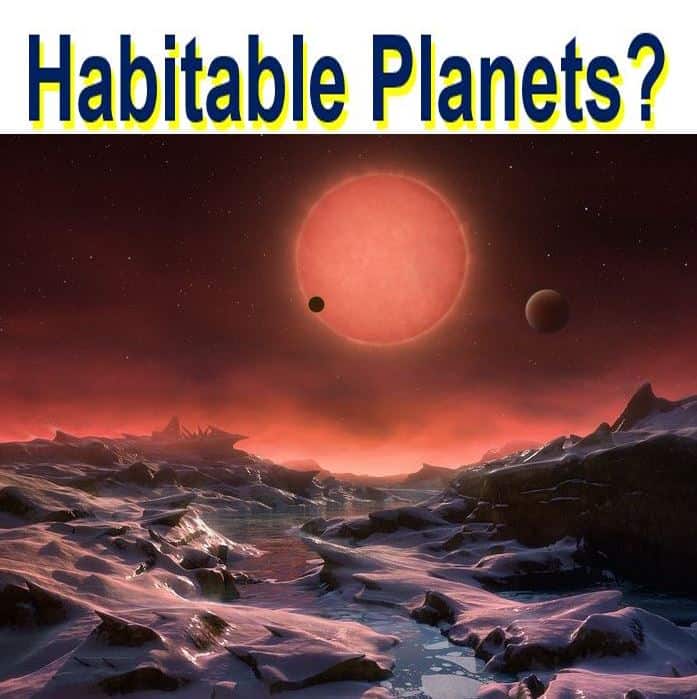 An artist’s impression showing an imagined view from the surface of one of the three exoplanets orbiting the ultra-cool dwarf star – TRAPPIST 1 – just 40 light-years from Earth. One of them could be a habitable planet, i.e. within the habitable zone where conditions might be ideal for life as we know it to exist. (Image: eso.org)
An artist’s impression showing an imagined view from the surface of one of the three exoplanets orbiting the ultra-cool dwarf star – TRAPPIST 1 – just 40 light-years from Earth. One of them could be a habitable planet, i.e. within the habitable zone where conditions might be ideal for life as we know it to exist. (Image: eso.org)
Just 40 light years away
The dwarf star and the three exoplanets are extremely close to Earth, astronomically speaking – just forty light years away. Their proximity means that astronomers should eventually be able to study the composition of each of the *exoplanets in greater detail, including their atmospheres and chemical signals of life.
*An exoplanet is a planet outside our Solar System.
Prof. Burgasser said:
“The kind of planets we’ve found are very exciting from the perspective of searching for life in the universe beyond Earth.”
The scientists used the Transiting Planets and Planetesimals Small Telescope (TRAPPIST)), located at the La Silla Observatory in Chile, to trace the star’s light moment-to-moment over the course of sixty-two nights, from September to December 2015.
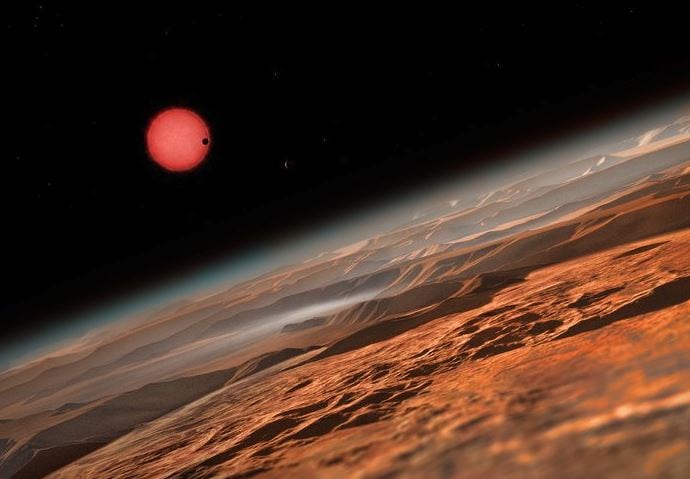 An artist’s depiction of the ultra-cool dwarf star seen from one of the three exoplanets. (Image: eso.org)
An artist’s depiction of the ultra-cool dwarf star seen from one of the three exoplanets. (Image: eso.org)
Team leader, Michaël Gillon, a research associate at the Institut d’Astrophysique et de Géophysique, University of Liège, Belgium, and colleagues analysed changes in the starlight’s brightness. They detected periodic dips as three planets traversed the star’s face casting shadows.
The University of Liège writes on its website:
“These new exoplanets have sizes and temperatures similar to Venus and Earth, making the existence of liquid water on their surfaces theoretically possible.”
“This discovery is a world first, because unlike all potentially habitable exoplanets detected so far, these new planets are well suited for a detailed study of their atmospheric compositions with the latest generation of telescopes, making the first search for traces of life around another star finally possible!”
Three exoplanets are Earth-sized
They followed up with observations using larger telescopes, which suggested that the planets are Earth-sized. Two of the exoplanets orbit the dwarf star once every 1.5 days and 2.5 days respectively, while the third has a less determined period ranging from 4.5 to 73 days.
Regarding the orbital periods of the three exoplanets, Dr. Gillon said:
“With such short orbital periods, the planets are between 20 and 100 times closer to their star than the Earth to the Sun. The structure of this planetary system is much more similar in scale to the system of Jupiter’s moons than to that of the Solar System.”
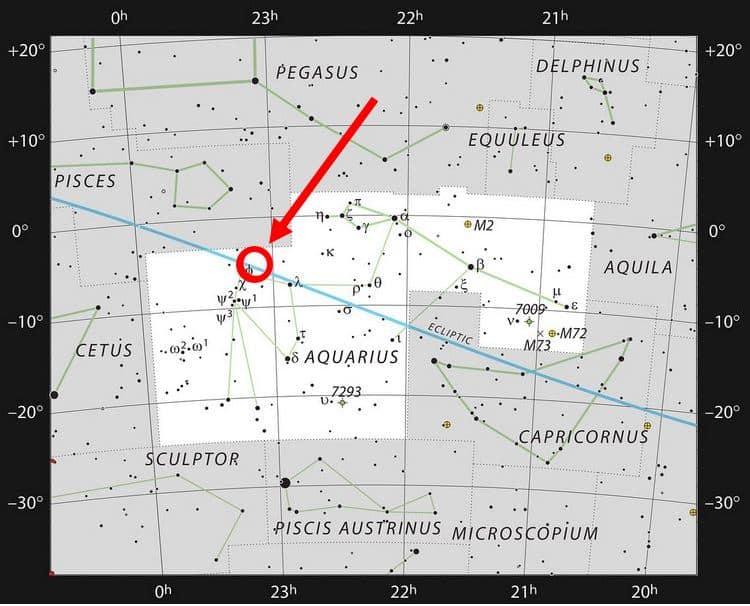 This chart shows the naked eye stars that are visible on a clear dark night in the sprawling constellation of Aquarius. The position of the faint and very red, ultra-cool dwarf star TRAPPIST-1 is marked (red circle). Although it is relatively close to the Sun (astronomically speaking), it is extremely faint and not visible using small telescopes. (Image: eso.org. Credit: ESO/IAU and Sky & Telescope)
This chart shows the naked eye stars that are visible on a clear dark night in the sprawling constellation of Aquarius. The position of the faint and very red, ultra-cool dwarf star TRAPPIST-1 is marked (red circle). Although it is relatively close to the Sun (astronomically speaking), it is extremely faint and not visible using small telescopes. (Image: eso.org. Credit: ESO/IAU and Sky & Telescope)
The researchers have determined that the three exoplanets are rocky and about the size of Earth. However, further measurements of their masses will be required to determine their compositions.
More importantly, even though their orbits are very close to their parent dwarf star, the two inner exoplanets only receive four times and twice, respectively, the amount of radiation our planet does, because their star is considerably fainter than our Sun.
Within the habitable zone
That puts them within the habitable zone. Their surfaces could possess habitable regions. However, complexities such as their atmospheres and clouds – that is, if they have atmospheres – make it difficult to predict whether conditions on the surface are really suitable for life as we know it.
The third planet, which is furthest from the star, has an orbit that is not yet well known. It probably receives less radiation than our own planet does, but could still lie within the habitable zone.
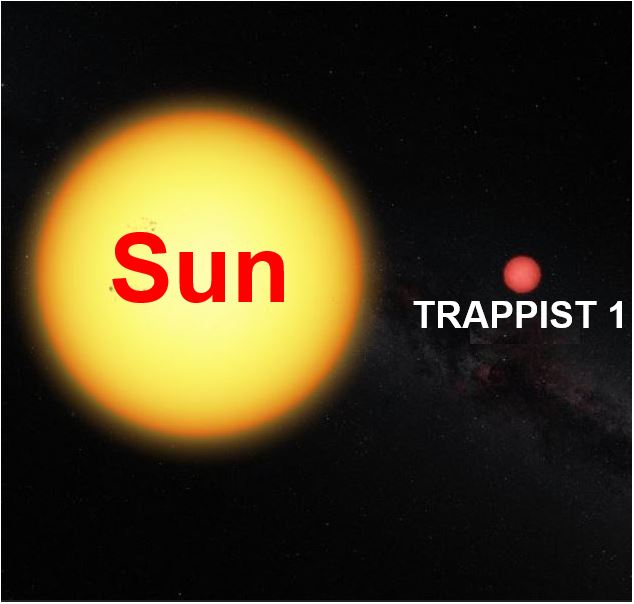 An artist’s depiction of our Sun versus TRAPPIST 1, the ultra-cool, faint dwarf star. It has only 11% of the diameter of our Sun, and is much redder. (Image: eso.org)
An artist’s depiction of our Sun versus TRAPPIST 1, the ultra-cool, faint dwarf star. It has only 11% of the diameter of our Sun, and is much redder. (Image: eso.org)
The authors said that the two planets nearest the parent star are probably tidally locked, i.e. with one side facing its parent star all the time, while the other side is always dark. That could reduce the circulation of water and atmosphere, which might become trapped on the dark, cold side, although the scientists speculate that life could potentially exist in the perpetual dawn at the day side’s western edge.
It is possible that tidal forces might keep the planet’s surface warm even on the cold side. However, vigorous geothermal activity could make the surfaces unstable.
We’ll know more with James Webb Space Telescope
Professor Burgasser said:
“Fortunately, we may be able to answer these questions in the near future, as the geometry of the system makes it likely that we will be able to detect the atmospheric gases of these planets in the next decade with the launch of the James Webb Space Telescope.”
“This facility will allow us to search for biogenic gases–oxygen or methane for example — that would firmly indicate the presence of life, or search for other gas species that would tell us about the planets’ compositions, geothermal activity and evolutionary history.”
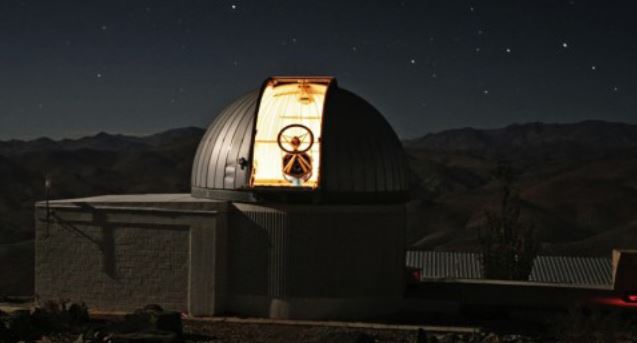 The Transiting Planets and Planetesimals Small Telescope (TRAPPIST) is a Belgian, remote & robotic telescope in Chile, which has been in operation since 2010. It is actually controlled from Liege in Belgium, with some autonomous features. (Image: ulg.ac.be)
The Transiting Planets and Planetesimals Small Telescope (TRAPPIST) is a Belgian, remote & robotic telescope in Chile, which has been in operation since 2010. It is actually controlled from Liege in Belgium, with some autonomous features. (Image: ulg.ac.be)
The parent star – called TRAPPIST 1 – is cool, dim, red, and so tiny, as far as stars go, that it is invisible to most telescopes – its diameter is just a little bigger than Jupiter’s. It is one tenth the size of our Sun, has approximately half its temperature, and is nearly 2,000 times fainter.
Most of what scientists know about it comes from observations in the infrared, the same type of invisible light that remote controllers emit.
Prof. Burgasser said:
“While such a ‘cold’ star might sound exotic, many, if not most, of the stars in our Milky Way Galaxy are of this cool, red, small and dim variety. If Earth-like planets around these stars turn out to be common, there may be many more habitable planets out there than current estimates predict.”
Although astrophysicists who are hunting for exoplanets are keen to see the James Webb Space Telescope deployed – now scheduled for launch in 2018 – the discovery team is already expanding observations of these exoplanets’ orbits and their magnetic interactions with the star.
Prof. Burgasser said:
“We expect intense scrutiny of this system by our colleagues, given its remarkable properties.”
Co-author Emmanuël Jehin, from the University of Liège, said:
“This really is a paradigm shift with regards to the planet population and the path towards finding life in the Universe. So far, the existence of such ‘red worlds’ orbiting ultra-cool dwarf stars was purely theoretical, but now we have not just one lonely planet around such a faint red star but a complete system of three planets!”
In an Abstract in the journal, the authors wrote:
“The infrared brightness of the host star, combined with its Jupiter-like size, offers the possibility of thoroughly characterizing the components of this nearby planetary system.”
Citation: “Temperate Earth-sized planets transiting a nearby ultracool dwarf star,” Michaël Gillon, Laetitia Delrez, Emmanuël Jehin, Susan M. Lederer, Julien de Wit, Artem Burdanov, Daniella Bardalez Gagliuffi, Pierre Magain, Valérie Van Grootel, Adam J. Burgasser, Amaury H. M. J. Triaud, Cyrielle Opitom, Brice-Olivier Demory, Devendra K. Sahu & Didier Queloz. Nature. 2 May 2016. DOI: 10.1038/nature17448.
Video – Best place to search for life
Where is the best place to search for life outside our solar system? This ESO (European Southern Observatory) video discusses the theme.
